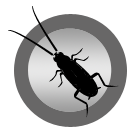 Cockroaches are nocturnal insects that live in cracks and crevices, both indoors and outside. They have flattened oval-shaped bodies, long antennae and bristly legs. Most cockroaches are black or brown in colour, and they are able to eat a wide range of foods, liquids and other organic materials (including leather, cardboard, fabric, glue and book binding)
Cockroaches are nocturnal insects that live in cracks and crevices, both indoors and outside. They have flattened oval-shaped bodies, long antennae and bristly legs. Most cockroaches are black or brown in colour, and they are able to eat a wide range of foods, liquids and other organic materials (including leather, cardboard, fabric, glue and book binding)
Types of Cockroaches
Across Australia, there are approximately 450 known species of cockroaches, however only a small number are considered pests. Throughout Joondalup and the northern suburbs of Perth, most cockroach problems are caused by:
American Cockroaches
Large red-brown cockroach, 30 – 45mm long. Mostly found in cavity walls, roof spaces, subfloor areas, sewers, drains, grease traps and rubbish bin areas.
Australian Cockroaches
Large dark brown cockroach, 30 – 35mm long. Has yellow markings on head and wings. Prefers foods of plant origin therefore mostly found outside, however also found in cavity walls, roof voids and subfloor areas.
Brownbanded Cockroaches
Small pale-brown cockroach, 10 – 15mm long. Mostly found indoors although not restricted to food areas. May also be found in wardrobes, dressers, cabinets, or behind bookcases
German cockroaches
Small light-brown cockroach, 12 – 15mm long. Prolific breeders. Mostly found in domestic / commercial kitchens or other food handling areas.
Smokeybrown Cockroaches
Large brown/black cockroach, 30 – 35mm long. Mostly found outside as prefer foods of plant origin, however also found in garages, sheds, subfloor areas, roof voids, and around grease traps and drains.
Problems caused by Cockroaches
For most people, the sight of a cockroach sparks feelings of fear or disgust – and for good reason. Cockroaches are capable of transmitting disease, contaminating surfaces they crawl on, emitting an unpleasant odour, and can cause allergic reactions for some people.
The main concern associated with cockroaches is their ability to transmit human diseases such as salmonella, gastroenteritis, dysentery, tuberculosis, hepatitis and typhoid fever. Cockroaches commonly scavenge in areas that support the growth of disease-causing organisms, such as sewers, grease traps and garbage areas. Cockroaches pick up bacteria in these areas and then carry them into food handling areas where surfaces are contaminated through droppings, cast skins, empty egg cases and mouth secretions.
Furthermore, contact with cockroaches or their excrement can bring about an allergic reaction in some people, and they have even been known to cause asthma attacks.
If you have concerns about cockroaches, please call WA Pestsaway Joondalup on 0419 374 374

